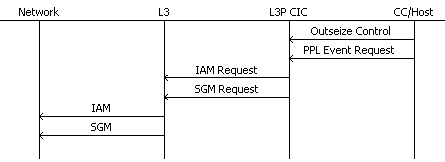
You are here: CSP Developerís Guide: Common Channel Signaling†>†4 SS7 Call Control for ISUP †>†ISUP Segmentation

Overview
ISUP is associated with SS7-specific voice and data call processing. It is used to set up circuit connections and to maintain those connections between end-point subscribers for the duration of a call, using SS7-controlled Circuit Identification Codes (CICs). Segmentation is used to enable faster and more efficient transfer of ISUP messages across a network using the Segmentation Message (SGM). This feature is associated with the ITU White Book, 1993 (Q.761 - Q.764)
The ISDN User Part (ISUP) Segmentation provides the capability of breaking down larger packets of data into smaller ones in order to achieve compatibility with any network protocol that requires the smaller packet size. This process is necessary whenever large blocks of data need to be transmitted across a network, to offset problems with both time delays and error correction that could lead to traffic congestion. ISUP Segmentation in this way conserves critical network resources.
Using the Segmentation Message (SGM)
The Message Transfer Part (MTP) functions as the lowest layer in the SS7 protocol stack, and it is this layer that communicates with the rest of the network. But MTP cannot send more than 272 bytes in a single message. With ISUP there is a need to transfer larger amounts of data, so the SGM message was introduced to segment any ISUP message over 272 bytes into two parts. This process allows the MTP to transfer it successfully. The two parts include the primary ISUP message and the SGM, which contains the segmented portion over 272 bytes. The SGM is sent immediately after the primary ISUP message to the MTP layer.
Each message can only be segmented once. If the information in the message is so large that even an SGM becomes insufficient, then that information will be discarded.
At the receiving end, the primary ISUP message and the Segmented portion are concatenated before processing.
PPL Information
Simple Segmentation Control (SSC) Component ID (0x85)
This is the ITU ISUP PPL component created to support the SGM message in the CSP. This component takes care of the segmentation process at the transmission end and the re-assembly of the ISUP message at the receiving end.
The ISUP CPC PPL component communicates through the SGM to the PPL SSC component.
The following messages are the only ones that can be sent or received using the SGM: IAM, ACM, ANM, CPG, and CON.
All other ISUP messages are transparent and are therefore passed through the SSC component without modifications or segmentation.
The host-to-CSP and CSP-to-host TCP message packet size is limited to 260 bytes and 492 bytes, respectively. Therefore, the ISUP message sent in a PPL Event Request from the host to the CSP cannot exceed 260 bytes.
When an ISUP message and its associated SGM are received by the PPL ITU SSC component, it will be divided into packets of 220 bytes each and then sent on to the L3P CIC PPL component.
The outgoing SGM can be enabled or disabled based on a configuration byte setting. The CPC Configuration Byte for SGM control is "0x04".
Configuration Bytes 0x01-0x05 are used for ISUP SCLC Component ID (0x85).
See SS7 PPL Information in this manual for more information on these configuration bytes.
Each PPL component has multi-purpose timers, which you can activate at any time. Each component using timers has a table that contains information on specific timers (name, value). When a protocol requires a timer, an atomic function is initiated to activate one of the PPL timers and to point to an index in the componentís timer table, which contains the value for the required timer.
One timer exists for the SSC PPL Component: 0x01
The PPL Indication "0x32" exists for the L3P CIC PPL Component (0x0F), for sending a Segmentation indication to the host.
SSC contains the atomic functions (51-63) that manage the segmentation and re-assembly of messages.
CPC contains the atomic functions (134-138) that communicate with the SSC component.
Redundancy for ISUP Segmentation is available.
Outgoing Call with Segmentation in IAM
The following call flow describes an outgoing call with Segmentation in IAM. After the host sends an Outseize Control message to L3P CIC, it then sends a PPL Event Request (0x60) to this component. After a setup request has been sent to CPC, and an IAM has been received by the network, an SGM message is sent to the network

.
Outgoing Call with Segmentation in IAM when COT is enabled
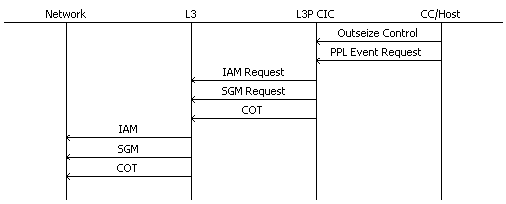
The following call flow describes segmentation in an ACM/ANM message.
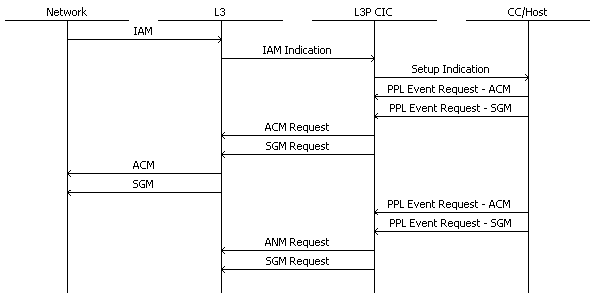
Incoming Segmentation with COT Enabled - COT Success
The following call flow describes an incoming call with segmentation and Continuity Check enabled.
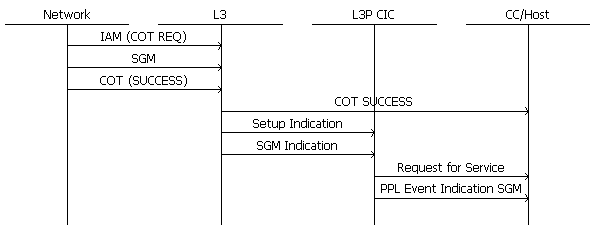
Incoming Call with Segmentation
The following call flow describes an incoming call with Segmentation. The SGM message is received after the IAM at the SSC component. Once the SGM is received, the RFS and the SGM message are sent to the host. (Alternatively, the SGM message and IAM can be concatenated and a single RFS can be sent to the host if the Configuration Byte 0x02 in the SSC component 0x85 is changed to 0x00.)
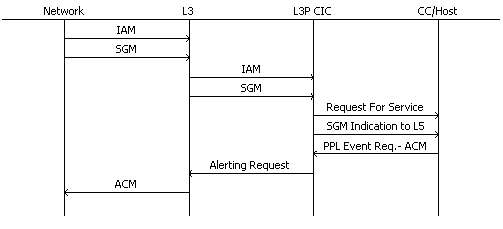
Outgoing Call with Segmentation in IAM and Backward Messages
When sending a large Outseize (> 272) bytes, the message is segmented by the SSC component. The following call flow shows a typical scenario for this process.
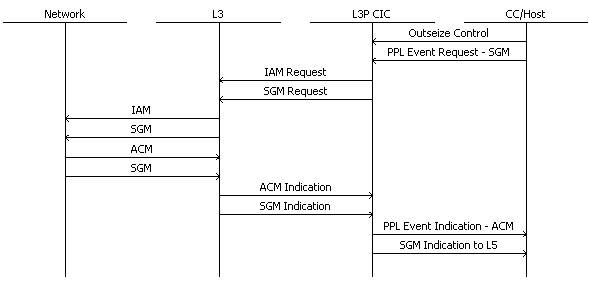
This call flow describes a scenario wherein the ACM message indicates that an SGM is to follow. However, if the SGM is not received until the expiry of T34 (typically 2 s), the ACM is forwarded to the Host. Any SGM message that follows is discarded.
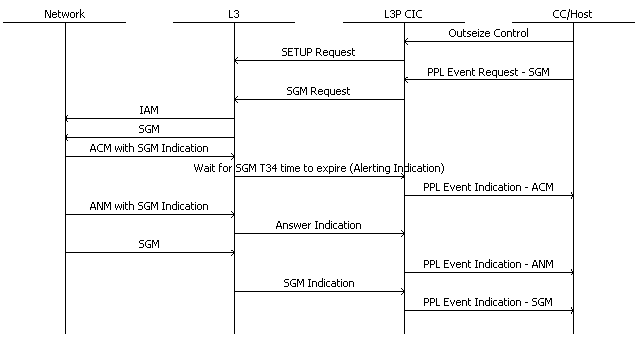
Segmentation with Continuity Failure

ANSI ISUP Segmentation
The ANSI ISUP Segmentation feature allows you to select different interpretation and segmentation handling for the forward indicator E bit in the Initial Address Message (IAM) for ANSI segmentation.
The ANSI ISUP specification T1.113 - 1995 defines the E bit of the forward indicator in Initial Address Message (IAM) as the IAM Segmentation Indicator. If the E bit is set in the IAM, the receiving exchange will start timer T36 and wait for the Information (INF) message. During this time, the Address Complete Message (ACM) will not be sent back even when requested by the host call control.
However, the ANSI ISUP specification T1.113 - 2000 defines the E bit of the forward indicator as a spare. In this case, ISUP implementation may run into the problem when receiving an IAM with the forward indicator E bit set, and call control requests such as Connect AB, PPL Event Requests of ACM from the host call control are received before timer T36 expires. These messages will be positively acknowledged, but the ACM will not be sent to the network. Eventually, the call fails when timer T7 expires from the transmission end.
The ISUP CPC PPL Component (0x0012) provides the ANSI ISUP Segmentation (0xD4) configuration byte to define whether the forward indicator E bit in the IAM should be interpreted as a segmentation indicator. When this configuration byte is set, timer T36 will be started for the INF message, and Call Control request for the ACM will not be processed if received before timer T36 expires. If this configuration byte is not set, the forward indicator E bit is considered as a spare, and the ACM can be sent out immediately, and there is no waiting period for the INF message.